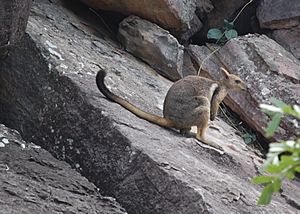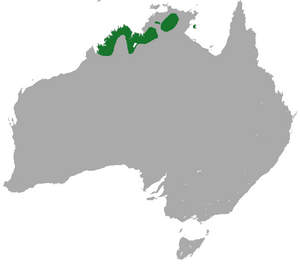Short-eared rock-wallaby facts for kids
Quick facts for kids Short-eared rock-wallaby |
|
|---|---|
 |
|
| Short-eared rock-wallaby in Kakadu National Park | |
| Conservation status | |
| Scientific classification | |
| Subspecies | |
|
|
 |
|
| Short-eared rock-wallaby range |
The short-eared rock-wallaby (Petrogale brachyotis) is a type of rock-wallaby. You can find it in northern Australia. It lives in the northern parts of the Northern Territory and Western Australia. This wallaby is bigger than its close relatives. These include the eastern short-eared rock-wallaby, the nabarlek, and the monjon.
Contents
About This Wallaby
Scientists first described the short-eared rock-wallaby in 1841. This was done by a person named John Gould.
In 2014, scientists studied the wallaby's genes and body features. They found that the eastern short-eared rock-wallaby was a separate species. Before this, people thought it was the same as P. brachyotis. The eastern short-eared rock-wallaby lives in Kakadu National Park and Litchfield National Park. It is smaller and has brighter colors.
Scientists have also looked at different groups within the short-eared rock-wallaby species. They think there might be two or even three different types.
What It Looks Like
The short-eared rock-wallaby is a member of the Petrogale family. Its size and color can be different depending on where it lives.
Its fur is grey-brown with shiny silver hairs. Its belly is a pale grey color. These wallabies are usually 41.5 to 55 centimeters (about 16 to 22 inches) long. They weigh between 2.2 and 5.5 kilograms (about 5 to 12 pounds).
Their tail is fairly short for a wallaby, about 32 to 55 centimeters (12 to 22 inches) long. The tail is cinnamon brown and has a dark brown or black tuft of fur at the end. Their ears are also small, measuring about 4 to 4.8 centimeters (1.5 to 1.9 inches).
The wallaby's legs are cinnamon colored. They have a light-colored stripe on their thigh that goes up over their side and shoulder. There is a darker patch below their front leg. A light patch is on the side of their nose, with a white stripe below it that reaches their eye. A dark stripe runs from the top of their head down their back. Wallabies living near the Victoria River and in the Kimberley region have duller colors and less clear stripes.
One type of short-eared rock-wallaby was first described from a sample found at Hanover Bay. Another type, called Petrogale brachyotis victoriae, was found near the Victoria River. Scientists are still studying this group. They might decide it is a separate species later.
How It Behaves
The short-eared rock-wallaby likes to live in groups. It is a vegetarian, meaning it eats plants. You can find these wallabies in rocky hills and gorges. They are generally grey-brown with white areas on their face and legs. This species is not considered to be in danger.
Where It Lives
Short-eared rock-wallabies live in many different places, but not everywhere in those areas. Their home range stretches from the border of Queensland and the Northern Territory, across the Top End, to Windjana Gorge in northwestern Australia.
They live in areas that get more than 600 millimeters (about 24 inches) of rain each year. You can also find them on islands in the Gulf of Carpentaria. They prefer living in monsoon rainforests and open grasslands. They use cliffs, hills, and valleys for safety and to find food.
In Aboriginal Culture
The Kunwinjku people in West Arnhem Land call this wallaby badbong. In the past, people would hunt badbong using spears in the rocky areas. An elder named Reverend Peterson Nganjmirra said they would trap badbong by setting fire to Triodia grass.
Conservation
The IUCN Red List checked the short-eared rock-wallaby's conservation status in 2015. They listed it as "least concern," meaning it is not currently threatened. However, scientists don't know if the number of these wallabies is growing or shrinking.
Some groups of wallabies have disappeared in the southern part of the Northern Territory. The wallabies in Western Australia have not been studied much. Changes in how fires are managed might harm local wallaby groups. Experts suggest more studies are needed to understand how these and other things affect this wallaby.
See also
 In Spanish: Ualabí rupestre de orejas cortas para niños
In Spanish: Ualabí rupestre de orejas cortas para niños


